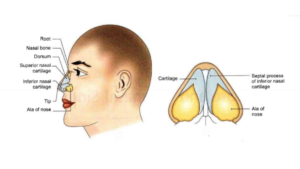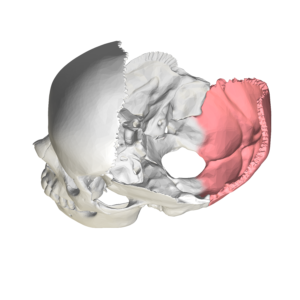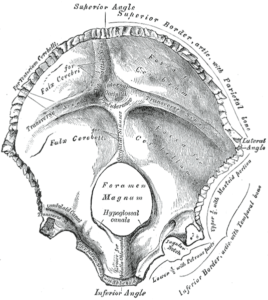
Parietal Bone: One Of the skull bone
The skull is a complex structure that plays a crucial role in protecting the brain and supporting the face. It is composed of 22 bones that are joined together by sutures, which are fibrous connective tissue that fuse the bones together. The skull bones can be divided into two main groups: the cranial bones and the facial bones.
The cranial bones make up the top and back of the skull, and their main function is to protect the brain. The eight cranial bones include the frontal bone, parietal bones, temporal bones, occipital bone, sphenoid bone, and ethmoid bone. Of these, the parietal bones are located on either side of the skull, between the frontal bone and occipital bone. They are irregularly quadrilateral in shape and form the majority of the vault and sides of the skull.
The parietal bones are essential for protecting the brain and providing structural support to the skull. They also contain various anatomical features, including the parietal eminence and parietal foramen. The parietal eminence is a bony prominence on the outer surface of the bone, while the parietal foramen is a small opening that allows for the passage of blood vessels and nerves.
In addition to their protective and structural functions, the parietal bones also play a role in sensory perception. They are involved in the processing of touch and pressure sensations, and damage to these bones can result in changes to these sensory perceptions.
- Surfaces :
- External
- Internal
- Borders
- Superior (sagittal),
- Inferior (squamosal).
- Anterior (frontal), and
- Posterior (occipital).
- Angles:
- Antero-superior (frontal),
- Antero-inferior (sphenoidal),
- Postero-superior (occipital) and
- Postero-inferior (mastoid).
Determination of side :
The determination of which side the parietal bone belongs to can be done by analyzing several characteristics of the bone.
- The superior (sagittal) border of the parietal bone is straight, thickly serrated, and the longest, which lies above in the median plane. By comparing the length and thickness of the superior border with the opposite parietal bone, one can determine which side the bone belongs to.
- The external surface of the parietal bone is convex, which means it curves outward. By comparing the shape of the external surface with the opposite parietal bone, one can determine which side the bone belongs to.
- The inferior border of the parietal bone is arched, which means it curves inward. By comparing the shape of the inferior border with the opposite parietal bone, one can determine which side the bone belongs to.
- The antero-inferior (sphenoidal) angle of the parietal bone is acute, which means it forms a sharp corner. By comparing the angle of the antero-inferior angle with the opposite parietal bone, one can determine which side the bone belongs to.
Surfaces of Parietal Bone
External surface :
The external surface of the parietal bone is smooth and convex in all directions.
- Parietal tuberosity (eminence):
The parietal tuberosity, also known as parietal eminence, is a rounded prominence on the surface of the parietal bone near its center. This bony landmark is significant for various reasons:
- The parietal eminence forms an important bony landmark on the skull, which is useful in identifying and locating different regions of the skull.
- It corresponds to the maximum transverse diameter of the skull, which means it helps in measuring the breadth of the skull.
- The parietal eminence corresponds to the upper end of the posterior ramus of the lateral sulcus of the cerebral hemisphere, which plays a crucial role in the structure and function of the brain.
- Opposite the parietal eminence lies the center for written and printed words, which is a crucial area for language and communication.
- The center of ossification first starts at the parietal eminence, which means it is the point where the parietal bone begins to develop and grow.
2. Temporal lines :
The external surface of the parietal bone contains two curved lines – the superior and inferior temporal lines. Here are some points to expand on the significance and function of these lines:
- The superior temporal line is located in the middle of the parietal bone’s external surface. This line serves as an attachment point for the temporal fascia, a layer of connective tissue that covers the temporal muscle.
- The area above the superior temporal line is covered by the galea aponeurotica, also known as the epicranial aponeurosis. This is a tough, fibrous layer of tissue that covers the scalp and provides an attachment point for several muscles, including the frontalis muscle.
- The inferior temporal line is located below the superior temporal line, and the area below it gives origin to the temporalis muscle. The temporalis muscle is a fan-shaped muscle that covers much of the temporal region and is responsible for jaw movement during chewing and speaking.
- The area below the inferior temporal line also forms part of the temporal fossa, a depression on the side of the skull that contains several structures, including the temporalis muscle, the deep temporal arteries, and the zygomatic arch.
- Both the superior and inferior temporal lines are important landmarks for identifying and studying the parietal bone and its surrounding structures. They also serve as attachment points for various muscles and connective tissues, contributing to the overall stability and movement of the head and neck.
3. Parietal foramen:
The parietal foramen is a small opening located near the posterior part of the superior border of the parietal bone. The size and shape of the foramen can vary among individuals and can be absent in some cases. The parietal foramen is the point of exit for the parietal emissary vein which runs through the skull and connects the venous sinuses within the cranial cavity with veins outside the skull. The parietal emissary vein can also be absent in some individuals. Although the presence or absence of the parietal foramen and parietal emissary vein may not have any significant clinical implications, it is an important anatomical feature that can be used to distinguish between different individuals.
The parietal foramen, located near the posterior part of the superior border of the parietal bone, has two important structures passing through it:
(a) A small branch of the occipital artery, which is a branch of the external carotid artery, passes through the parietal foramen. This branch supplies blood to the scalp, skull bones, and meninges.
(b) An emissary vein connecting the superior sagittal sinus, which is a large venous channel that drains blood from the brain, to the occipital vein, which is a vein that drains blood from the back of the head and neck. This vein is known as the parietal emissary vein and it helps in regulating the pressure within the cranial cavity.
The internal (cerebral) surface of the parietal bone is deeply concave and forms part of the cranial cavity, which encloses and protects the brain. The internal surface is divided into four regions, each corresponding to a lobe of the brain:
(a) The frontal region, which corresponds to the frontal lobe of the brain.
(b) The parietal region, which corresponds to the parietal lobe of the brain.
(c) The occipital region, which corresponds to the occipital lobe of the brain.
(d) The temporal region, which corresponds to the temporal lobe of the brain.
The internal surface of the parietal bone is smooth and covered by a thin layer of connective tissue called the dura mater, which is one of the three layers of the meninges that surround and protect the brain. The dura mater also forms a tough protective covering for the spinal cord.
The parietal bone presents various features on its internal surface, which include:
(i) Sagittal sulcus: a shallow longitudinal groove along the superior (sagittal) border that, with a similar groove on the opposite bone, forms the sagittal sulcus. The sulcus lodges the superior sagittal sinus, and the margins of the sulcus give attachment to the falx cerebri.
(ii) Granular foveolae: small, irregular pits located on each side of the sagittal sulcus that lodge arachnoid granulations.
(iii) Grooves for branches of the middle meningeal vessels: The impression for the anterior branch begins at or near the anteroinferior angle, and that of the posterior division starts at a close distance from the posteroinferior angle.
(iv) Impressions for cerebral gyri: the internal surface of the parietal bone has several impressions that correspond to the convolutions of the brain. These impressions give attachment to the pia mater.
Borders of Parietal Bone
The parietal bone is a flat, paired bone located on the superior aspect of the skull. It is divided into four borders that articulate with other bones of the skull to form sutures. These sutures are important landmarks in the skull and help to stabilize and protect the brain.
- Superior (sagittal) border: This is the longest border of the parietal bone and is straight and thickly serrated. It articulates with the corresponding border of the opposite parietal bone to form the sagittal suture. The sagittal suture runs along the midline of the skull, separating the left and right parietal bones.
- Inferior (squamosal) border: The inferior border of the parietal bone is arched and divided into three parts.
- Anterior: This part is beveled at the expense of its outer surface and articulates with the greater wing of the sphenoid. The greater wing of the sphenoid is a bone that forms part of the floor of the cranial cavity.
- Intermediate: This part is also arched and beveled at the expense of its outer surface and articulates with the squamous part of the temporal bone. The squamous part of the temporal bone is a flat, scale-like bone that forms the lower lateral part of the skull.
- Posterior: This part is straight and thickly serrated and articulates with the mastoid part of the temporal bone. The mastoid part of the temporal bone is a rounded protrusion located behind the ear.
- Anterior (frontal) border: The anterior border of the parietal bone is thick and deeply serrated. It is beveled at the expense of its inner surface above and the outer surface below and articulates with the posterior (parietal) border of the frontal bone to form one half of the coronal suture. The coronal suture runs from one ear to the other, separating the frontal bone from the parietal bones.
- Posterior (occipital) border: The posterior border of the parietal bone is also thick and serrated. It articulates with the parietal (lambdoid) border of the squamous part of the occipital bone to form one half of the lambdoid suture. The lambdoid suture is a curved suture that separates the parietal bones from the occipital bone.
Lambda:
The lambda is an important anatomical landmark located at the posterior aspect of the skull where the sagittal and lambdoid sutures meet. It is the meeting point of two parietal bones and the occipital bone. The sagittal suture runs along the midline of the skull, separating the left and right parietal bones, while the lambdoid suture separates the parietal bones from the occipital bone.
In the fetal skull, the lambda is the site of the posterior fontanelle, which is an unossified membranous part of the skull. The fontanelle is a soft spot on the skull that allows for flexibility during childbirth and brain growth during infancy. As the skull bones grow and fuse together, the fontanelle eventually ossifies, and the lambda becomes a solid bony landmark.
Angles:
- Antero-superior (frontal) angle: formed by the meeting of sagittal and frontal borders: corresponds with bregma (meeting point of sagittal and coronal sutures).
- Antero-inferior (sphenoidal) angle: thin and most pointed. It is formed by the meeting of frontal and squamosal borders: corresponds with pterion.
- The pterion is the meeting place of 4 bones-frontal. parietal,
sphenoid (its greater wing), and temporal (it’s a squamous part), at the sphenoidal angle of the parietal bone. It is an important bony landmark.
Importance:
- Opposite this point lies:
- the anterior division of the middle meningeal artery.
- the division of the stem of the lateral sulcus of the cerebral hemisphere into its three rami.
- Broca’s motor speech center of the brain.
- Postero-superior (occipital) angle: formed by the meeting of sagittal and occipital borders, corresponds with lambda.
- Postero-inferior (mastoid) angle: blunt; formed by the meeting of occipital and squamosal borders; corresponds with asterion.
Asterion
The asterion is a bony landmark located at the junction of three bones: parietal, occipital, and temporal. Specifically, it is the meeting place of the mastoid part of the temporal bone, the occipital bone, and the parietal bone at the mastoid angle of the parietal bone. On its internal surface, the asterion has a sulcus, which is an indentation or groove, where the transverse sinus ends and the sigmoid sinus begins.
The transverse sinus is one of the venous sinuses of the brain that drains blood from the back of the head and the cerebellum. It runs along the tentorium cerebelli, a fold of the dura mater that separates the cerebrum from the cerebellum, and eventually empties into the sigmoid sinus. The sigmoid sinus, in turn, continues down as the internal jugular vein, which eventually drains into the superior vena cava.
The asterion is an important anatomical landmark for neurosurgeons and radiologists who use it to identify the location of the transverse and sigmoid sinuses on imaging studies. Knowledge of the asterion and its relationship to these important structures is particularly relevant in neurosurgical procedures that involve the posterior fossa of the skull or the venous sinuses of the brain.
Conclusion
The parietal bone is two in number, situated between the frontal bone in front and occipital bone behind. It is irregularly quadrilateral in shape. This bone overlies the parietal bone of the brain. The two together form the greater part of the vault and the sides of the skull. It articulates with the other five bones like the frontal, sphenoid, temporal, occipital, and contralateral parietal bones. The Parietal bone protects the underlying brain structure i.e. parietal lobe.



